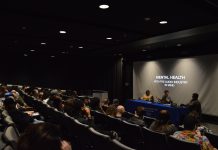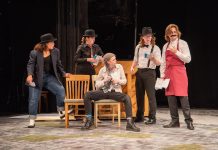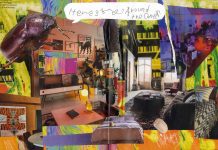After serving in the Army infantry, Webster University senior Riley Williams is still fighting, but this time through a different form: art. His artwork is inspired by a politically darker meaning than the bright colors that meet the eye.
Williams said that his work is a statement toward the way society, any society, glorifies the actions of the military. The bad guy and good guy differ in every culture, yet Williams said he believes there is no need to promote the bad the military does, regardless of their good reasons.

“We are mimicking the bad actions,” Williams said. “If we would follow the good reason then we would all get along. Then there would be no reason for killing, so why celebrate the idea?”
Before the military and with no formal education, Williams had no choice but to work odd jobs that barely paid the bills. Facing financial problems, Williams enlisted in the Army in 2006 to support his son. In 2009, his service ended.
Williams spent his life in the U.S. Army as an infantryman when the U.S. was at war with Afghanistan. Those in the infantry are considered to be the mainland combat force and backbone of the army, according to Go Army. Although Williams did not go into detail about his time spent in the service, he did explain his realization behind his artworks concept.
“If you apply the realistic idea of what [war] is, and what it’s doing to the world or someone else, you don’t want to apply it to play anymore,” Williams said.
When it came to trauma, art was Williams’ comfort space. He said he has turned to art his whole life. In fourth grade, Williams’ family moved from California to North Carolina. The culture shock between the two communities sent him into solitude with a pen and paper. He began doodling as an escape. Williams didn’t really fall in love with art until after he was out of the military. The escape he once sought out in art during his younger age became more necessary.
In 2013, Williams came to Webster to get his BFA in fine arts.
Webster art professor Tate Foley described Williams’ art as a delicate balance between attraction and repulsion. Foley said that people are attracted to the paintings because of the bright, bold colors and the nice geometric shapes that could exist in any space.
“When you start to understand the tone and what he’s really bringing to the table, it really does put a sinister spin on what he’s thinking about.”
Williams work is not about the U.S. Military or any other country’s military, but a military as a whole. His piece titled “Mike” is a balance between WWI British Dazzle ship camouflage (also known as Razzle Dazzle) and the Army Service Ribbon.
Instead of using expensive paints, Williams prefers what he calls “utilitarian” paint: regular oil-based paint (used to paint front doors) and standard household spray paints from Lowe’s or Home Depot. He said he believes by using everyday paint, he can portray everyday people who are transformed during recruitment.

“People who join the military are just regular people,” Williams said. “Especially during the Vietnam draft, people were just picked off the shelf. I try to apply the same concept to my work.”
Foley said he believes the artwork is directly correlated to Williams’ time spent overseas and in the military.
“I think that so much of it is derived from who Riley is and his history,” Foley said. “He is keenly attentive to the world around him right now. He’s not necessarily telling stories with his paintings from his past, but rather meshing both worlds [art world and our world], which is very contemporary.”
Ron Gibbs, development Officer at Leigh Gerdine College of Fine Arts, purchased one of Williams’ pieces after attending a small showing of the artwork.
“I loved the depth of it,” Gibbs said. “It’s kind of three-dimensional looking, and I also loved the use of his colors. It’s just beautiful to look at.”
A non-objective piece of art means there is no visual image depicted compared to abstract art, which abstracts and changes the visual image. Williams said that for many artists, having their artwork “stand alone” (without the artist being present to describe the piece) is the ultimate goal. Although Williams said there is a drawback to being non-objective (it is a little more difficult to have a conversation with the piece), Williams continued to distort his pieces to the point where it is no longer obvious and made a statement.
“With non-objectivity comes confusion,” Williams said. “With confusion comes conversation. How can we fix any problem

without a conversation?”
Williams said he believes being in a gallery or public works can help him reach certain people who could potentially make a difference.
“You can see some great graffiti and art pieces in places but they end up getting lost in the mix,” Williams said. “If they would use their art and put it in a situation to where it was a focal point for conversation, it would change things for the better.”




HE IS A MILITARY IMPOSTER!!! This is an interesting article especially seeing as this man, Riley Williams, NEVER SAW ACTIVE DUTY and DID NOT COMPLETE BASIC TRAINING. Did you ask to see his DD214 card when this article was written? He is a military imposter and is a disgrace to both those true heroes who have served our country and to other artists due to the lies he tells. Do your research when publishing.
Comments are closed.